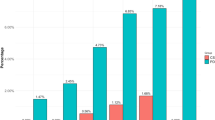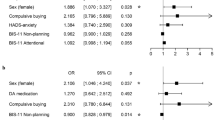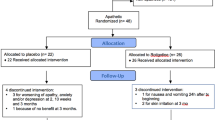Abstract
Impulse control disorders (ICDs) constitute a group of relatively common psychiatric conditions. ICDs typically involve pleasurable or hedonic behaviors (e.g. gambling, shopping or sex) that are performed repetitively, excessively or compulsively, to an extent that interferes in major areas of life functioning. Over the past decade, case reports, case studies and controlled examinations have reported ICDs in neurological patients, particularly those with Parkinson's disease (PD). A relationship between dopamine agonist treatment and ICDs was initially suggested on the basis of clinical observations, and subsequent systematic studies have provided more-substantial support for this association. Ongoing studies of the clinical characteristics of individuals with PD with and without ICDs suggest that certain individuals might be at increased risk of developing ICDs during PD treatment. Emerging data suggest that the association between dopamine agonists and ICDs extends into other neurological patient populations in which these agents are employed, such as those with restless legs syndrome. In this article, we summarize current knowledge regarding ICDs, review their relationships with PD and its treatments, provide practical clinical recommendations based on existing data, and suggest avenues for future research directed at advancing clinical care strategies.
Key Points
-
Current estimates suggest that impulse control disorders (ICDs) are exhibited by approximately 6–7% of individuals with Parkinson's disease (PD)
-
ICDs typically identified in patients with PD fall into the domains of gambling, sex, shopping and eating
-
Among individuals with PD, specific clinical features—including young age, impulsive or novelty-seeking personality features, personal or family history of alcoholism, history of an ICD before PD onset, and dopamine agonist therapy—have been found to be associated with ICDs
-
ICDs can be challenging to recognize because the behaviors are typically hedonic, and excessive engagement in these behaviors might be associated with guilt or embarrassment
-
Treatment approaches can involve switching dopaminergic therapies, applying behavioral and pharmacological treatments used for ICDs in non-PD populations, and engaging spouses or other family members and psychiatric consultation, although limited empirical evidence for these approaches exists at the present time
-
Further investigation into the nature of the relationships between ICDs and PD should help to optimize prevention and treatment strategies
This is a preview of subscription content, access via your institution
Access options
Subscribe to this journal
Receive 12 print issues and online access
$209.00 per year
only $17.42 per issue
Buy this article
- Purchase on Springer Link
- Instant access to full article PDF
Prices may be subject to local taxes which are calculated during checkout
Similar content being viewed by others
References
American Psychiatric Association (2000) Diagnostic and Statistical Manual of Mental Disorders Fourth Edition: DSM-IV-TR. Washington, DC: American Psychiatric Association
Moeller FG et al. (2001) Psychiatric aspects of impulsivity. Am J Psychiatry 158: 1783–1793
Aboujaoude E et al. (2006) Potential markers for problematic internet use: a telephone survey of 2,513 adults. CNS Spectrums 11: 750–755
Koran LM et al. (2006) Estimated prevalence of compulsive buying in the United States. Am J Psychiatry 163: 1806–1812
Grant JE et al. (2005) Impulse control disorders in adult psychiatric inpatients. Am J Psychiatry 162: 2184–2188
Hollander E et al. (2007) OCSDs in the forthcoming DSM-V. CNS Spectrums 12: 320–323
Bienvenu OJ et al. (2000) The relationship of obsessive-compulsive disorder to possible spectrum disorders: results from a family study. Biol Psychiatry 48: 287–293
Lochner C et al. (2005) Cluster analysis of obsessive-compulsive spectrum disorder in patients with obsessive-compulsive disorder: clinical and genetic correlates. Comp Psychiatry 46: 14–19
Holden C (2001) 'Behavioral' addictions: do they exist? Science 294: 980–982
Hollander E and Wong CM (1995) Obsessive-compulsive spectrum disorders. J Clin Psychiatry 56 (Suppl 4): 3–6
Potenza MN (2007) Impulsivity and compulsivity in pathological gambling and obsessive-compulsive disorder. Rev Bras Psiquiatr 29: 105–106
Grant JE and Potenza MN (2006) Compulsive aspects of impulse control disorders. Psychiatr Clin North Am 29: 539–551
Brewer JA and Potenza MN (2007) The neurobiology and genetics of impulse control disorders: relationships to drug addictions. Biochem Pharmacol [doi:10.1016/j.bcp.2007.06.043]
Yin HH and Knowlton BJ (2006) The role of basal ganglia in habit formation. Nat Neurosci 7: 464–476
Dalley JW et al. (2007) Nucleus accumbens D2/3 receptors predict trait impulsivity and cocaine reinforcement. Science 315: 1267–1270
Tamminga CA and Nestler EJ (2006) Pathological gambling: focusing on the addiction, not the activity. Am J Psychiatry 163: 180–181
Potenza MN (2006) Should addictive disorders include non-substance-related conditions? Addiction 101: 142–151
Potenza MN et al. (2001) Pathological gambling. JAMA 286: 141–144
Slutske WS et al. (2000) Common genetic vulnerability for pathological gambling and alcohol dependence in men. Arch Gen Psychiatry 57: 666–674
Stinchfield R (2003) Reliability, validity and classification accuracy of a measure of DSM-IV diagnostic criteria for pathological gambling. Am J Psychiatry 160: 180–182
Kessler RC et al. (2006) The prevalence and correlates of DSM-IV intermittent explosive disorder in the National Comorbidity Survey Replication. Arch Gen Psychiatry 63: 669–678
Shaffer HJ et al. (1999) Estimating the prevalence of disordered gambling in the United States and Canada: a research synthesis. Am J Public Health 89: 1369–1376
Petry NM et al. (2005) Co-morbidity of DSM-IV pathological gambling and other psychiatric disorders: results from the National Epidemiologic Survey on Alcohol and Related Conditions. J Clin Psychiatry 66: 564–574
Ladd GT and Petry NM (2002) Disordered gambling among university-based medical and dental patients: a focus on internet gambling. Psychol Addict Behav 16: 76–79
Morasco BJ et al. (2006) Severity of gambling is associated with physical and emotional health in urban primary care patients. Gen Hosp Psychiatry 28: 94–100
Pasternak AV and Fleming MF (1999) Prevalence of gambling disorders in a primary care setting. Arch Fam Med 8: 515–520
Weintraub D et al. (2006) Dopamine agonist use is associated with impulse control disorders in Parkinson's disease. Arch Neurology 63: 969–973
Voon V et al. (2006) Prevalence of repetitive and reward-seeking behaviors in Parkinson's disease. Neurology 67: 1254–1257
Voon V et al. (2006) Prospective prevalence of pathological gambling and medication association in Parkinson's disease. Neurology 66: 1750–1752
Chambers RA and Potenza MN (2003) Neurodevelopment, impulsivity and adolescent gambling. J Gambl Stud 19: 53–84
Wilber MK and Potenza MN (2006) Adolescent gambling: research and clinical implications. Psychiatry 2006 3: 40–48
McElroy SL et al. (1994) Compulsive buying: a report of 20 cases. J Clin Psychiatry 55: 242–248
Grant JE and Potenza MN (2006) Impulse control disorders. In A Clinical Text of Men's Mental Health, 205–232 (Eds Grant JE and Potenza MN) Washington, DC: American Psychiatric Publishing
Petry NM (2003) Gambling participation and problems among Southeast Asian refugees. Psychiatr Serv 54: 1142–1148
Blaszczynski A et al. (1997) Impulsivity in pathological gambling: the antisocial impulsivist. Addiction 92: 75–87
Petry NM (2001) Substance abuse, pathological gambling, and impulsiveness. Drug Alcohol Depend 63: 29–38
Potenza MN et al. (2002) Gambling: an addictive behavior with health and primary care implications. J Gen Int Med 17: 721–732
Desai RA et al.: Gambling, health and age: data from the National Epidemiologic Survey on Alcohol and Related Conditions. Psychol Addict Behav, in press
Pietrzak RH et al. (2007) Gambling level and psychiatric and medical disorders in older adults: results from the National Epidemiologic Survey on Alcohol and Related Conditions. Am J Geriatr Psychiatry 15: 301–313
Grant JE et al. (2005) Impulse control disorders in adult psychiatric inpatients. Am J Psychiatry 162: 2184–2188
Eisen SA et al. (1998) Familial influences on gambling behavior: an analysis of 3359 twin pairs. Addiction 93: 1375–1384
Potenza MN et al. (2005) Shared genetic contributions to pathological gambling and major depression in men. Arch Gen Psychiatry 62: 1015–1021
Slutske WS et al. (2001) A twin study of the association between pathological gambling and antisocial personality disorder. J Abnorm Psychol 110: 297–308
Desai RA and Potenza MN : Gender differences in the associations between problem gambling and psychiatric disorders. Soc Psychiatry Psychiatr Epidemiol, in press
Cunningham-Williams RM et al. (1998) Taking chances: problem gamblers and mental health disorders—results from the St. Louis Epidemiologic Catchment Area Study. Am J Public Health 88: 1093–1096
Potenza MN (2007) Impulse control disorders and co-occurring disorders: dual diagnosis considerations. J Dual Diagn 3: 47–57
Weintraub D and Potenza MN (2006) Impulse control disorders in Parkinson's disease. Curr Neurol Neurosci Rep 6: 302–306
Voon V et al. (2007) Medication-related impulse control and repetitive behaviors in Parkinson's disease. Curr Opin Neurol 20: 484–492
Molina JA et al. (2000) Pathological gambling in Parkinson's disease: a behavioral manifestation of pharmacologic treatment? Mov Disord 15: 869–872
Gschwandtner U et al. (2001) Pathological gambling in patients with Parkinson's Disease. Clin Neuropharmacol 24: 170–172
Seedat S et al. (2000) Pathological gambling behaviour: emergence secondary to treatment of Parkinson's disease with dopaminergic agents. Depress Anxiety 11: 185–186
Serrano-Dueñas M (2002) Chronic dopamimetic drug addiction and pathologic gambling in patients with Parkinson's disease—presentation of four cases. German J Psychiatry 5: 62–66
Driver-Dunkley E et al. (2003) Pathological gambling associated with dopamine agonist therapy in Parkinson's disease. Neurology 61: 422–423
Giovannoni G et al. (2000) Hedonic homeostatic dysregulation in patients with Parkinson's disease on dopamine replacement therapies. J Neurol Neurosurg Psychiatry 68: 423–428
Klos KJ et al. (2005) Pathological hypersexuality predominantly linked to adjuvant dopamine agonist therapy in Parkinson's disease and multiple system atrophy. Parkinsonism Relat Disord 11: 381–386
Sensi M et al. (2004) Explosive-aggressive behavior related to bilateral subthalamic stimulation. Parkinsonism Relat Disord 10: 247–251
Fasano A et al. (2006) Punding and computer addiction in Parkinson's disease. Mov Disord 21: 1217–1275
Nirenberg MJ and Waters C (2005) Compulsive eating and weight gain related to dopamine agonist use. Mov Disord 21: 524–529
Borek LL and Friedman (2005) Levodopa addiction in idiopathic Parkinson disease. Neurology 65: 1508
Evans AH et al. (2004) Punding in Parkinson's disease: its relationship to the dopamine dysregulation syndrome. Mov Disord 19: 397–405
Pezzella FR et al. (2005) Prevalence and clinical features of hedonic homeostatic dysregulation in Parkinson's disease. Mov Disord 20: 77–81
Gallagher DA et al. (2007) Pathological gambling in Parkinson's disease: risk factors and differences from dopamine dysregulation: an analysis of published case series. Mov Disord 22: 1757–1763
Friedman J (1994) Punding on levodopa. Biol Psychiatry 36: 350–351
Dodd ML et al. (2005) Pathological gambling caused by drugs used to treat Parkinson disease. Arch Neurol 62: 1377–1381
Grosset KA et al. (2006) Problem gambling on dopamine agonists: not such a rarity. Mov Disord 21: 2206–2208
Kurlan R (2004) Disabling repetitive behaviors in Parkinson's disease. Mov Disord 19: 433–469
Witjas T et al. (2005) Addiction in Parkinson's disease: impact of deep brain stimulation. Mov Disord 20: 1052–1055
Galvez-Jimenez N (2007) Rasagiline- and selegiline-induced hypersexuality and other impulse control disorders (ICD) in Parkinson's disease (PD). Presented at the Impulse Control Disorders in Parkinson's Disease Workshop: 2007 July 12–13, Toronto, ON, Canada
Smeding HMM et al. (2007) Pathological gambling after bilateral subthalamic nucleus stimulation in Parkinson's disease. J Neurol Neurosurg 78: 517–519
Pontone G et al. (2006) Clinical features associated with impulse control disorders in Parkinson disease. Neurology 67: 1258–1261
Szarfman A et al. (2006) Association between pathological gambling and parkinsonian therapy as detected in the Food and Drug Administration Adverse Event database. Arch Neurol 63: 299–300
Reuter J et al. (2005) Pathological gambling is linked to reduced activation of the mesolimbic reward system. Nat Neurosci 8: 147–148
Williams WA and Potenza MN The neurobiology of impulse control disorders. Rev Bras Psiquiatr, in press
Voon V et al. (2007) Factors associated with dopaminergic drug-related pathological gambling in Parkinson's disease. Arch Neurol 64: 212–216
Ardouin C et al. (2006) Pathological gambling in Parkinson's disease improves on chronic subthalamic nucleus stimulation. Mov Disord 21: 1941–1946
Hui JS et al. (2007) Compulsive behaviors in Parkinson's disease: looking beyond medication. Presented at the Impulse Control Disorders in Parkinson's Disease Workshop: 2007 July 12–13, Toronto, ON, Canada
Evans AH et al. (2005) Factors influencing susceptibility to compulsive dopaminergic drug use in Parkinson disease. Neurology 65: 1570–1574
Burn DJ and Troster AI (2004) Neuropsychiatric complications of medical and surgical therapies for Parkinson's disease. J Geriatr Psychiatry Neurol 17: 172–180
Galpern WR and Stacy M (2007) Management of impulse control disorders in Parkinson's disease. Curr Treat Options Neurol 9: 189–197
Brewer JA et al.: The treatment of pathological gambling. Addict Disord Treat, in press
Grant JE and Potenza MN (2007) Treatments for pathological gambling and other impulse control disorders. In A Guide to Treatments that Work, 561–577 (Eds Nathan P and Gorman J) Oxford: Oxford University Press
Evans AH et al. (2006) Relationship between impulsive sensation seeking traits, smoking, alcohol and caffeine intake, and Parkinson's disease. J Neurol Neurosurg Psychiatry 77: 317–321
Weintraub D (2007) Clinical scales in ICD assessment. Presented at the Impulse Control Disorders in Parkinson's Disease Workshop: 2007 July 12–13, Toronto, ON, Canada
Potenza MN et al. (2006) Characteristics of older adult problem gamblers calling a gambling helpline. J Gambl Stud 22: 241–254
Desai RA (2004) Older adults. In Pathological Gambling: A Clinical Guide to Treatment, 83–96 (Eds Grant JE and Potenza MN) Washington, DC: American Psychiatric Publishing
Mamikonyan E et al. (2007) Long-term follow-up of impulse control disorders in Parkinson's disease. Presented at the 11th International Congress of Parkinson's Disease and Movement Disorders: 2007 June 3–7, Istanbul, Turkey
Grant JE et al. (2003) Paroxetine treatment of pathological gambling: a multi-center randomized controlled trial. Int Clin Psychopharmacol 18: 243–249
Shaffer HJ and Hall MN (2002) The natural history of gambling and drinking problems among casino employees. J Soc Psychol 142: 405–424
Hollander E et al. (2004) Pharmacological treatments. In Pathological Gambling: A Clinical Guide to Treatment, 189–206 (Eds Grant JE and Potenza MN) Washington, DC: American Psychiatric Publishing
Hollander E et al. (2005) Does sustained-release lithium reduce impulsive gambling and affective instability versus placebo in pathological gamblers with bipolar spectrum disorders? Am J Psychiatry 162: 137–145
Grant JE and Potenza MN (2006) Escitalopram treatment of pathological gambling with co-occurring anxiety: an open-label pilot study with double-blind discontinuation. Int Clin Psychopharmacol 21: 203–209
Teixeira-Júnior AL and Cardoso F (2005) Factitious disorder mimicking addiction to levodopa in a patient with advanced Parkinson's disease. Arq Neuropsiquiatr 63: 324–326
Avanzi M et al. (2006) Prevalence of pathological gambling in patients with Parkinson's disease. Mov Disord 21: 2068–2072
Zack M and Poulos CX (2007) A D2 antagonist enhances the rewarding and priming effects of a gambling episode in pathological gamblers. Neuropsychopharmacology 32: 1678–1686
Bonci A and Singh V (2006) Dopamine dysregulation syndrome in Parkinson's disease patients: from reward to penalty. Ann Neurol 59: 733–734
Evans AH et al. (2006) Compulsive drug use linked to sensitized ventral striatal dopamine transmission. Ann Neurol 59: 852–858
Cilia R et al. (2007) Neural networks underlying pathological gambling in Parkinson's disease: a resting-state perfusion SPECT study. Presented at the Impulse Control Disorders in Parkinson's Disease Workshop: 2007 July 12–13, Toronto, ON, Canada
Weintraub D (2007) Compulsive behaviors I. Presented at the Impulse Control Disorders in Parkinson's Disease Workshop: 2007 July 12–13, Toronto, ON, Canada
Evans AH et al. (2007) Dopamine agonist-induced pathological gambling in restless legs syndrome due to multiple sclerosis. Mov Disord 22: 590–591
Acknowledgements
This work was supported by the US Department of Veterans Affairs (the Veterans Affairs Connecticut-Massachusetts Mental Illness Research, Education and Clinical Center [MIRECC], Veterans Affairs Research Enhancement Award Program [REAP] and the Veterans Affairs Neuroscience and Traumatic Brain Injuries Post-doctoral Fellowship), the National Institute on Drug Abuse (grant R01-DA019039), and Women's Health Research at Yale.
Author information
Authors and Affiliations
Corresponding author
Ethics declarations
Competing interests
The authors provide disclosure of possible competing interests, whether or not directly related to the proposed work. Dr Potenza consults for and is an advisor to Boehringer Ingelheim, receives research support from Mohegan Sun, has consulted for and has financial interests in Somaxon, and has consulted for law offices and the federal defender's office as an expert in pathological gambling and impulse control disorders. Dr Weintraub receives research support from and is an advisor to Boehringer Ingelheim, and has been an advisor to Schwarz Pharma. Dr Voon has no competing interests to report.
Rights and permissions
About this article
Cite this article
Potenza, M., Voon, V. & Weintraub, D. Drug Insight: impulse control disorders and dopamine therapies in Parkinson's disease. Nat Rev Neurol 3, 664–672 (2007). https://doi.org/10.1038/ncpneuro0680
Received:
Accepted:
Issue Date:
DOI: https://doi.org/10.1038/ncpneuro0680
This article is cited by
-
Prognosis of impulse control disorders in Parkinson’s disease: a prospective controlled study
Journal of Neurology (2024)
-
Implications of dopaminergic medication withdrawal in Parkinson’s disease
Journal of Neural Transmission (2022)
-
Dopaminergic Influences on Emotional Decision Making in Euthymic Bipolar Patients
Neuropsychopharmacology (2014)
-
Drug-induced dyskinesia in Parkinson's disease. Should success in clinical management be a function of improvement of motor repertoire rather than amplitude of dyskinesia?
BMC Medicine (2013)
-
Management of Motor and Non-Motor Symptoms in Parkinson’s Disease
CNS Drugs (2013)



